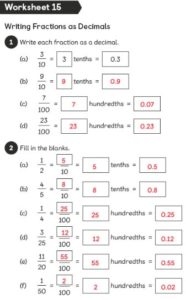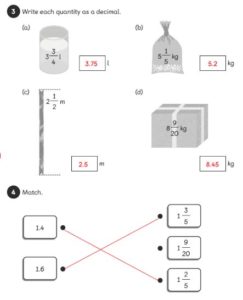Tuesday 28th April
Good morning everyone.
Maths No Problem
1st Answer pages for last Monday’s Lesson 15


Today’s lesson: Chapter 8 Decimals … Lesson 16 – Dividing whole numbers by 10
Lesson Objective: To be able to divide 1- or 2-digit numbers by 10.
Textbook pages: 51 – 53 Workbook pages 31 – 32
Lesson Notes: To begin this lesson, show pupils the In Focus task and ask them how the bars of chocolate can be shared equally among 10 children. Allow them to discuss this with their partners and then ask them to share their answers with the class. Explain to pupils that when dividing 3 by 10, what we need to do is to divide each whole into 10 parts, and distribute each part to each child. Draw the 3 bars divided into 10 parts each. Show how the parts are distributed. Each child will get 1⁄10 from each bar, and 3⁄10 from 3 bars. How do we write 3⁄10 as a decimal? 3⁄10 = 0.3. So we know that 3 divided by 10 = 0.3. Show a few more examples, using 4 bars of chocolate shared equally among 10 children, and then divide 5 bars among 10 children. Guide pupils to see that when a whole number is divided by 10, the digit remains the same, but its place value changes from ones to tenths.
Display Let’s Learn 2. What is the same and what is different about this question? How can we use what we have just learnt to help with this question? Show pupils how to calculate the answer using the images in the textbook. Explain what has happened using a place-value chart. Provide pupils with other 2-digit numbers to divide by 10 and ask them to describe the effect.
During Guided Practice, pupils are dividing a 1-digit and a 2-digit number by 10.
WHITE ROSE MATHS
If you want some more maths to do, or perhaps a break from Maths No Problem, go to the link below. It is by White Rose Maths who have created some video lessons and associated worksheets (+answer sheets) for each year group. It is very good and self-explanatory. Have a look and see what you think.
https://whiterosemaths.com/homelearning/
Mental Maths / Arithmetic
Practice dividing where there is a remainder.
This video tutorial might help you
Have a go at these:
65 ÷ 3 = 89 ÷ 4 = 259 ÷ 5 = 457 ÷ 4 = 2753 ÷ 2 = 7462 ÷ 4 =
Writing Task
We will continue with the Talk for Writing – King of the Fishes
Today I would like you to:
1st … how good are you at story telling the King of Fishes? Do you need to practice it a bit more?
If you are confident in telling the story with great expression and maybe some actions, you could (if you want to) video yourself telling it and email it to me. I’d love to see how you are getting on and I’ll post them onto the class blog.
2nd do the tasks on page 13 which is some more grammar work about making sentences better for the reader by starting with a fronted adverbial (don’t forget that if you start a sentence with a fronted adverbial you MUST have a comma).
Spellings
Don’t forget to practice this week’s spellings: early, earth, eight, enough, exercise.
Make sure that you know the meaning of each word. Perhaps you could write sentences with the words in.
Reading
Please don’t forget to read today. ‘The more you read, the more you know. The more you know, the more places you will go.’ You should be able to access the book quizzes and don’t forget to go on Lexia (if you have a log in) for 15 minutes each day. Well done everyone.



